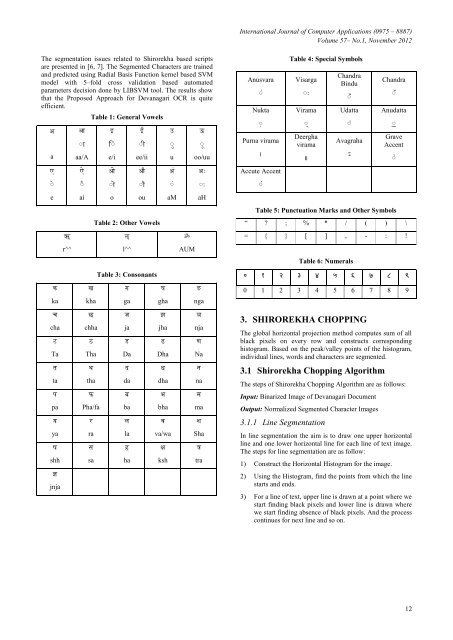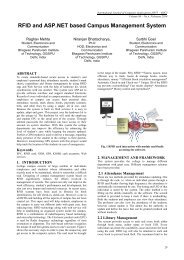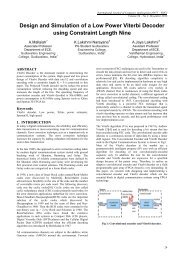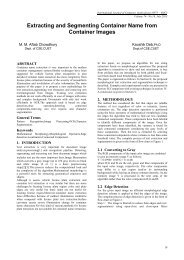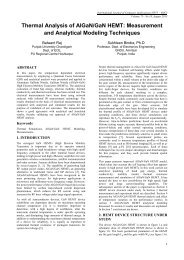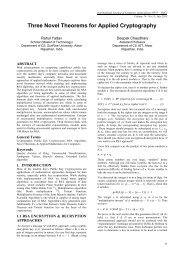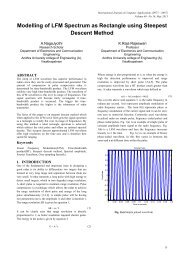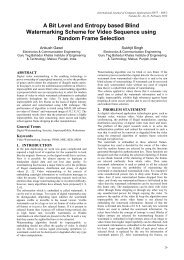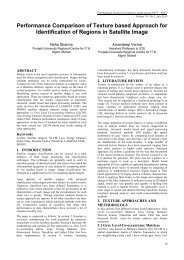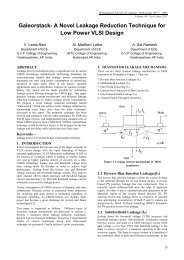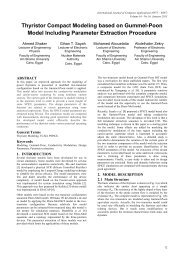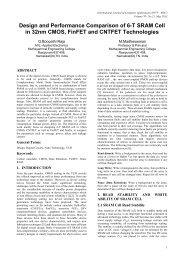Robust Printed Devanagari Document Recognition using Hybrid ...
Robust Printed Devanagari Document Recognition using Hybrid ...
Robust Printed Devanagari Document Recognition using Hybrid ...
Create successful ePaper yourself
Turn your PDF publications into a flip-book with our unique Google optimized e-Paper software.
International Journal of Computer Applications (0975 – 8887)<br />
Volume 57– No.1, November 2012<br />
The segmentation issues related to Shirorekha based scripts<br />
are presented in [6, 7]. The Segmented Characters are trained<br />
and predicted <strong>using</strong> Radial Basis Function kernel based SVM<br />
model with 5–fold cross validation based automated<br />
parameters decision done by LIBSVM tool. The results show<br />
that the Proposed Approach for <strong>Devanagari</strong> OCR is quite<br />
efficient.<br />
अ<br />
a<br />
आ<br />
ा<br />
aa/A<br />
Table 1: General Vowels<br />
इ<br />
िा<br />
e/i<br />
ई<br />
ा<br />
ee/ii<br />
उ<br />
ा<br />
u<br />
ऊ<br />
ा<br />
oo/uu<br />
Anusvara<br />
ां<br />
Nukta<br />
ा<br />
Purna virama<br />
।<br />
Table 4: Special Symbols<br />
Visarga<br />
ाः<br />
Virama<br />
ा<br />
Deergha<br />
virama<br />
॥<br />
Chandra<br />
Bindu<br />
ा<br />
Udatta<br />
ा<br />
Avagraha<br />
ऽ<br />
Chandra<br />
ा<br />
Anudatta<br />
ा<br />
Grave<br />
Accent<br />
ा<br />
ए<br />
ऐ<br />
ओ<br />
औ<br />
अं<br />
अः<br />
Accute Accent<br />
ा<br />
ा<br />
ा<br />
ा<br />
ां<br />
ाः<br />
ा<br />
e<br />
ai<br />
o<br />
ou<br />
aM<br />
aH<br />
Table 5: Punctuation Marks and Other Symbols<br />
Table 2: Other Vowels<br />
“ ? ; % * / ( ) \<br />
ॠ<br />
ॡ<br />
ॐ<br />
= { } [ ] , - : !<br />
r^^<br />
l^^<br />
AUM<br />
Table 6: Numerals<br />
Table 3: Consonants<br />
० १ २ ३ ४ ५ ६ ७ ८ ९<br />
क<br />
ka<br />
ख<br />
kha<br />
ग<br />
ga<br />
घ<br />
gha<br />
ङ<br />
nga<br />
0 1 2 3 4 5 6 7 8 9<br />
च<br />
cha<br />
ट<br />
Ta<br />
छ<br />
chha<br />
ठ<br />
Tha<br />
ज<br />
ja<br />
ड<br />
Da<br />
झ<br />
jha<br />
ढ<br />
Dha<br />
ञ<br />
nja<br />
ण<br />
Na<br />
3. SHIROREKHA CHOPPING<br />
The global horizontal projection method computes sum of all<br />
black pixels on every row and constructs corresponding<br />
histogram. Based on the peak/valley points of the histogram,<br />
individual lines, words and characters are segmented.<br />
त<br />
ta<br />
प<br />
pa<br />
थ<br />
tha<br />
फ<br />
Pha/fa<br />
द<br />
da<br />
ब<br />
ba<br />
ध<br />
dha<br />
भ<br />
bha<br />
न<br />
na<br />
म<br />
ma<br />
3.1 Shirorekha Chopping Algorithm<br />
The steps of Shirorekha Chopping Algorithm are as follows:<br />
Input: Binarized Image of <strong>Devanagari</strong> <strong>Document</strong><br />
Output: Normalized Segmented Character Images<br />
य<br />
ya<br />
ष<br />
shh<br />
ज्ञ<br />
jnja<br />
र<br />
ra<br />
स<br />
sa<br />
ल<br />
la<br />
ह<br />
ha<br />
व<br />
va/wa<br />
क्ष<br />
ksh<br />
श<br />
Sha<br />
त्र<br />
tra<br />
3.1.1 Line Segmentation<br />
In line segmentation the aim is to draw one upper horizontal<br />
line and one lower horizontal line for each line of text image.<br />
The steps for line segmentation are as follow:<br />
1) Construct the Horizontal Histogram for the image.<br />
2) Using the Histogram, find the points from which the line<br />
starts and ends.<br />
3) For a line of text, upper line is drawn at a point where we<br />
start finding black pixels and lower line is drawn where<br />
we start finding absence of black pixels. And the process<br />
continues for next line and so on.<br />
12


